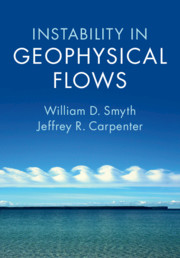Refine search
Actions for selected content:
8123 results in Fluid dynamics and solid mechanics
16 - Magnetic Relaxation under Topological Constraints
- from Part III - Dynamic Aspects of Dynamo Action
-
- Book:
- Self-Exciting Fluid Dynamos
- Published online:
- 13 May 2019
- Print publication:
- 25 April 2019, pp 441-462
-
- Chapter
- Export citation

Instability in Geophysical Flows
-
- Published online:
- 17 April 2019
- Print publication:
- 11 April 2019
-
- Book
-
- You have access
- Open access
- Export citation
Appendix B - Projects
-
- Book:
- Instability in Geophysical Flows
- Published online:
- 17 April 2019
- Print publication:
- 11 April 2019, pp 307-316
-
- Chapter
-
- You have access
- Open access
- Export citation
4 - Parallel Shear Flow: the Effects of Stratification
- from Part I - Normal Mode Instabilities
-
- Book:
- Instability in Geophysical Flows
- Published online:
- 17 April 2019
- Print publication:
- 11 April 2019, pp 107-136
-
- Chapter
-
- You have access
- Open access
- Export citation
6 - Synthesis: Viscous, Diffusive, Inhomogeneous, Parallel Shear Flow
- from Part I - Normal Mode Instabilities
-
- Book:
- Instability in Geophysical Flows
- Published online:
- 17 April 2019
- Print publication:
- 11 April 2019, pp 153-173
-
- Chapter
-
- You have access
- Open access
- Export citation
13 - Refining the Numerical Methods
- from Part II - The View Ahead
-
- Book:
- Instability in Geophysical Flows
- Published online:
- 17 April 2019
- Print publication:
- 11 April 2019, pp 273-286
-
- Chapter
-
- You have access
- Open access
- Export citation
10 - Summary
- from Part I - Normal Mode Instabilities
-
- Book:
- Instability in Geophysical Flows
- Published online:
- 17 April 2019
- Print publication:
- 11 April 2019, pp 242-244
-
- Chapter
-
- You have access
- Open access
- Export citation
Preface
-
- Book:
- Instability in Geophysical Flows
- Published online:
- 17 April 2019
- Print publication:
- 11 April 2019, pp ix-x
-
- Chapter
-
- You have access
- Open access
- Export citation
3 - Instabilities of a Parallel Shear Flow
- from Part I - Normal Mode Instabilities
-
- Book:
- Instability in Geophysical Flows
- Published online:
- 17 April 2019
- Print publication:
- 11 April 2019, pp 53-106
-
- Chapter
-
- You have access
- Open access
- Export citation
Part II - The View Ahead
-
- Book:
- Instability in Geophysical Flows
- Published online:
- 17 April 2019
- Print publication:
- 11 April 2019, pp 245-246
-
- Chapter
-
- You have access
- Open access
- Export citation
References
-
- Book:
- Instability in Geophysical Flows
- Published online:
- 17 April 2019
- Print publication:
- 11 April 2019, pp 317-322
-
- Chapter
-
- You have access
- Open access
- Export citation
7 - Nonparallel Flow: Instabilities of a Cylindrical Vortex
- from Part I - Normal Mode Instabilities
-
- Book:
- Instability in Geophysical Flows
- Published online:
- 17 April 2019
- Print publication:
- 11 April 2019, pp 174-194
-
- Chapter
-
- You have access
- Open access
- Export citation
8 - Instability in a Rotating Environment
- from Part I - Normal Mode Instabilities
-
- Book:
- Instability in Geophysical Flows
- Published online:
- 17 April 2019
- Print publication:
- 11 April 2019, pp 195-221
-
- Chapter
-
- You have access
- Open access
- Export citation
1 - Preliminaries
- from Part I - Normal Mode Instabilities
-
- Book:
- Instability in Geophysical Flows
- Published online:
- 17 April 2019
- Print publication:
- 11 April 2019, pp 3-23
-
- Chapter
-
- You have access
- Open access
- Export citation
12 - Instability and Turbulence
- from Part II - The View Ahead
-
- Book:
- Instability in Geophysical Flows
- Published online:
- 17 April 2019
- Print publication:
- 11 April 2019, pp 262-272
-
- Chapter
-
- You have access
- Open access
- Export citation
Appendix A - Homework Exercises
-
- Book:
- Instability in Geophysical Flows
- Published online:
- 17 April 2019
- Print publication:
- 11 April 2019, pp 287-306
-
- Chapter
-
- You have access
- Open access
- Export citation
9 - Convective Instability in Complex Fluids
- from Part I - Normal Mode Instabilities
-
- Book:
- Instability in Geophysical Flows
- Published online:
- 17 April 2019
- Print publication:
- 11 April 2019, pp 222-241
-
- Chapter
-
- You have access
- Open access
- Export citation
Frontmatter
-
- Book:
- Instability in Geophysical Flows
- Published online:
- 17 April 2019
- Print publication:
- 11 April 2019, pp i-iv
-
- Chapter
-
- You have access
- Open access
- Export citation
Part I - Normal Mode Instabilities
-
- Book:
- Instability in Geophysical Flows
- Published online:
- 17 April 2019
- Print publication:
- 11 April 2019, pp 1-2
-
- Chapter
-
- You have access
- Open access
- Export citation
Contents
-
- Book:
- Instability in Geophysical Flows
- Published online:
- 17 April 2019
- Print publication:
- 11 April 2019, pp v-viii
-
- Chapter
-
- You have access
- Open access
- Export citation
